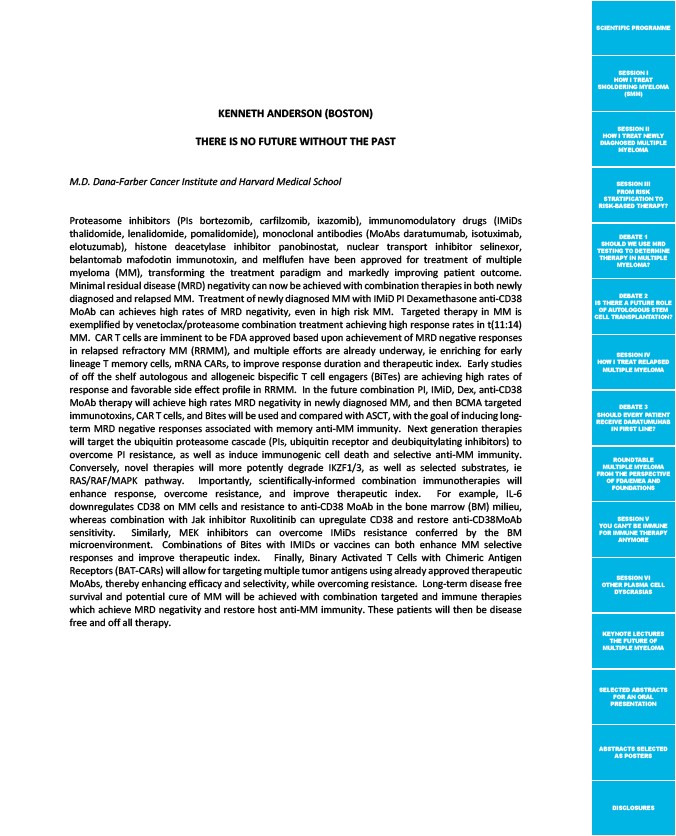
SCIENTIFIC PROGRAMME
SESSION I
HOW I TREAT
SMOLDERING MYELOMA
(SMM)
SESSION II
HOW I TREAT NEWLY
DIAGNOSED MULTIPLE
MYELOMA
SESSION III
FROM RISK
STRATIFICATION TO
RISK-BASED THERAPY?
DEBATE 1
SHOULD WE USE MRD
TESTING TO DETERMINE
THERAPY IN MULTIPLE
MYELOMA?
DEBATE 2
IS THERE A FUTURE ROLE
OF AUTOLOGOUS STEM
CELL TRANSPLANTATION?
SESSION IV
HOW I TREAT RELAPSED
MULTIPLE MYELOMA
DEBATE 3
SHOULD EVERY PATIENT
RECEIVE DARATUMUMAB
IN FIRST LINE?
ROUNDTABLE
MULTIPLE MYELOMA
FROM THE PERSPECTIVE
OF FDA/EMEA AND
FOUNDATIONS
SESSION V
YOU CAN’T BE IMMUNE
FOR IMMUNE THERAPY
ANYMORE
SESSION VI
OTHER PLASMA CELL
DYSCRASIAS
KEYNOTE LECTURES
THE FUTURE OF
MULTIPLE MYELOMA
SELECTED ABSTRACTS
FOR AN ORAL
PRESENTATION
ABSTRACTS SELECTED
AS POSTERS
DISCLOSURES
KENNETH ANDERSON (BOSTON)
THERE IS NO FUTURE WITHOUT THE PAST
M.D. Dana-Farber Cancer Institute and Harvard Medical School
Proteasome inhibitors (PIs bortezomib, carfilzomib, ixazomib), immunomodulatory drugs (IMiDs
thalidomide, lenalidomide, pomalidomide), monoclonal antibodies (MoAbs daratumumab, isotuximab,
elotuzumab), histone deacetylase inhibitor panobinostat, nuclear transport inhibitor selinexor,
belantomab mafodotin immunotoxin, and melflufen have been approved for treatment of multiple
myeloma (MM), transforming the treatment paradigm and markedly improving patient outcome.
Minimal residual disease (MRD) negativity can now be achieved with combination therapies in both newly
diagnosed and relapsed MM. Treatment of newly diagnosed MM with IMiD PI Dexamethasone anti-CD38
MoAb can achieves high rates of MRD negativity, even in high risk MM. Targeted therapy in MM is
exemplified by venetoclax/proteasome combination treatment achieving high response rates in t(11:14)
MM. CAR T cells are imminent to be FDA approved based upon achievement of MRD negative responses
in relapsed refractory MM (RRMM), and multiple efforts are already underway, ie enriching for early
lineage T memory cells, mRNA CARs, to improve response duration and therapeutic index. Early studies
of off the shelf autologous and allogeneic bispecific T cell engagers (BiTes) are achieving high rates of
response and favorable side effect profile in RRMM. In the future combination PI, IMiD, Dex, anti-CD38
MoAb therapy will achieve high rates MRD negativity in newly diagnosed MM, and then BCMA targeted
immunotoxins, CAR T cells, and Bites will be used and compared with ASCT, with the goal of inducing long-term
MRD negative responses associated with memory anti-MM immunity. Next generation therapies
will target the ubiquitin proteasome cascade (PIs, ubiquitin receptor and deubiquitylating inhibitors) to
overcome PI resistance, as well as induce immunogenic cell death and selective anti-MM immunity.
Conversely, novel therapies will more potently degrade IKZF1/3, as well as selected substrates, ie
RAS/RAF/MAPK pathway. Importantly, scientifically-informed combination immunotherapies will
enhance response, overcome resistance, and improve therapeutic index. For example, IL-6
downregulates CD38 on MM cells and resistance to anti-CD38 MoAb in the bone marrow (BM) milieu,
whereas combination with Jak inhibitor Ruxolitinib can upregulate CD38 and restore anti-CD38MoAb
sensitivity. Similarly, MEK inhibitors can overcome IMiDs resistance conferred by the BM
microenvironment. Combinations of Bites with IMIDs or vaccines can both enhance MM selective
responses and improve therapeutic index. Finally, Binary Activated T Cells with Chimeric Antigen
Receptors (BAT-CARs) will allow for targeting multiple tumor antigens using already approved therapeutic
MoAbs, thereby enhancing efficacy and selectivity, while overcoming resistance. Long-term disease free
survival and potential cure of MM will be achieved with combination targeted and immune therapies
which achieve MRD negativity and restore host anti-MM immunity. These patients will then be disease
free and off all therapy.